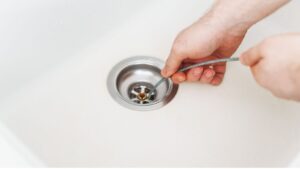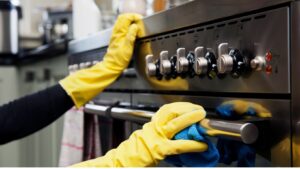If you turn off a self-cleaning oven early, the cleaning process will not finish. This can cause leftover grime and debris to accumulate, which may lead to damage and unpleasant smells.
Cleaning your oven is a necessary task to keep it running efficiently and prevent it from becoming a fire hazard. Self-cleaning ovens have a high-temperature cycle that burns away any food or residue inside. However, if you turn off your self-cleaning oven early, you risk interrupting the cleaning process.
This can result in baked-on grime and debris that can damage your oven’s interior and create unpleasant smells. In this article, we’ll explore what happens when you turn off a self-cleaning oven early and provide tips on how to clean it effectively without causing any damage.
What Is A Self-Cleaning Oven?
Self-cleaning ovens are appliances that use high heat to burn off and remove food residue and grease. They are designed to make cleaning easier, by reducing the need for harsh chemicals and laborious scrubbing, that often come with manual cleaning.
Definition Of A Self-Cleaning Oven
A self-cleaning oven uses extremely high temperatures to burn off the food debris and grease inside the oven, without any chemicals or manual labor.
- It has a built-in cleaning system that automatically cleans the oven cavity and the racks.
- The temperature inside the oven rises to extremely high levels, between 800°f – 900°f, during the cleaning cycle.
- The residue and grease inside are burned away completely, producing ash, which can be easily wiped away.
How Does A Self-Cleaning Oven Work?
Self-cleaning ovens have a unique cleaning cycle, which operates by following these steps:
- Lock the oven door: Self-cleaning ovens have a lock mechanism, which keeps the oven door locked during the cleaning cycle.
- Remove any visible debris: Before starting the cleaning cycle, it’s important to remove any large pieces of debris from inside the oven.
- Turn on the cleaning cycle: After you start the cleaning cycle, the oven heats up to extremely high temperatures (800°f – 900°f), which burns off any remaining food residue and grease.
- Wait for cooling: After the cleaning cycle is complete, it takes some time for the oven to cool down. This is because the oven retains heat for a while after the cycle has finished.
- Remove the ash: Once the oven has cooled down, you can wipe away the ash residue with a damp cloth.
The Different Types Of Self-Cleaning Ovens
There are two types of self-cleaning ovens available:
- Pyrolytic self-cleaning ovens: These ovens use high temperatures (up to 900°f) and take about 2-3 hours to clean. They turn the grease and debris inside the oven into ash, which can be wiped away.
- Catalytic self-cleaning ovens: These ovens use a special coating on the oven walls that absorbs the grease and debris inside the oven while it is in use. They require manual cleaning of the door and racks, but the oven interior doesn’t get as dirty as it does with a regular oven.
Turning off a self-cleaning oven early is not recommended. It may result in a dirty oven interior and may leave some residue that needs manual cleaning. Always ensure to follow the manufacturer’s recommended cleaning cycle duration for best results.
Advantages And Disadvantages Of Self-Cleaning Ovens
Self-cleaning ovens are quite convenient and time-saving appliances. They are designed to clean themselves, which means that all you have to do is initiate the cleaning process and wait for it to be completed. However, like every other thing, self-cleaning ovens have their advantages and disadvantages.
Pros Of Using A Self-Cleaning Oven:
- Self-cleaning ovens are quite convenient as they save you the trouble of manually scrubbing the oven.
- They use high heats to burn off any food residue and grease in the oven, which leaves your oven clean and stainless.
- Self-cleaning ovens are time-saving, as the cleaning process takes only a few hours.
- You do not need any cleaning chemicals when cleaning a self-cleaning oven.
Cons Of Using A Self-Cleaning Oven:
- Self-cleaning ovens use an incredibly high temperature during the cleaning process. This can lead to overheating, which can cause damage to your oven.
- There’s a possibility of the oven door being locked during the cleaning process, which means you cannot use the oven until the cleaning process is complete.
- Self-cleaning ovens are not suitable for people with respiratory problems. The high heat creates fumes that may cause breathing difficulties for some people.
- The high heat also generates a strong, unpleasant odor that may linger for several hours, sometimes up to 24 hours.
Safe Use Of Self-Cleaning Ovens
- Before starting the cleaning process, remove any large food residues from the oven to prevent smoke.
- Make sure that the ventilation is well established to avoid any respiratory problems.
- Do not interrupt the cleaning cycle, always wait for the oven to cool before opening the door.
- Keep children and pets away from the oven when the cleaning cycle is in progress.
- While the oven is in the cleaning cycle, do not use the cooktop.
The use of self-cleaning ovens has its advantages and disadvantages, but if used safely, they are a convenient and time-saving appliance. Remember to read the manufacturer’s instructions carefully before using the self-cleaning feature on your oven.
The Dangers Of Turning Off A Self-Cleaning Oven Early
A self-cleaning oven is an appliance that saves you time and effort in keeping your oven clean. All you need to do is set the duration and temperature, and the oven will do the rest. However, what would happen if you turn off a self-cleaning oven early?
We will discuss the dangers of turning off a self-cleaning oven early, including the potential damage to the oven, safety hazards, and malfunctions.
Explanation Of Self-Cleaning Oven Temperature And Duration
Before discussing the dangers of turning off a self-cleaning oven early, let’s first understand how self-cleaning ovens work. Self-cleaning ovens work by heating the oven to high temperatures- typically around 900°f – which melts and burns off the food particles, grease, and other residues that are stuck in the oven walls, racks, and surfaces.
The oven’s high heat will cause the stuck material to turn into ash, which can be easily wiped clean after the oven cools down.
The duration of the self-cleaning process usually depends on the oven model and the level of soiling. The self-cleaning cycle typically lasts between 2 to 4 hours.
What Happens When A Self-Cleaning Oven Is Turned Off Early?
If you turn off a self-cleaning oven early, there can be several consequences, such as the following:
- Incomplete cleaning: The most obvious result of turning off the oven early is that you will not get your oven cleaned properly. The self-cleaning process takes a particular amount of time to remove all the food debris and grease that accumulates in your oven. If you stop the process early, parts of the deposits will remain, and they will be harder to clean later on.
- Safety hazards: Self-cleaning ovens operate at extremely high temperatures, which is why it is critical to let the cleaning process finish. If you stop the process early, there is a risk of fire that can result from remnants of grime left behind in the oven.
Potential Damage To The Oven
Stopping the cleaning process early can also cause damage to your oven, including:
- Fuses blowing: Self-cleaning ovens can cause circuit overload, which can blow a fuse. Killing the self-cleaning feature early might trigger a power surge that might blow the fuses.
- Malfunctions: Turning off the self-cleaning cycle early can cause the oven’s sensor to malfunction. As a result, the oven’s temperature may fluctuate, and the oven may not work correctly.
You can cause harm to your oven if you turn off the self-cleaning cycle early. It is critical to let the cycle finish entirely to avoid damaging your oven and to ensure the safest possible use of the appliance.
Precautions When Using A Self-Cleaning Oven
Safety precautions when operating a self-cleaning oven:
- Always read the manufacturer’s instructions before using a self-cleaning oven.
- Wear oven mitts when touching the oven during and after the cleaning cycle.
- Keep children and pets away from the oven when it’s in cleaning mode.
- Ensure that the oven is properly ventilated during the cleaning process.
- Do not use cleaning sprays or other oven cleaners inside the oven during self-cleaning mode.
- Never leave the oven unattended when in cleaning mode.
Recommended practices when using a self-cleaning oven:
- Start the self-cleaning process when you have enough time, as it can take up to three hours.
- Remove as much debris and food particles from the oven as possible before starting the cleaning process.
- Check that the oven door is properly sealed before starting the cleaning cycle.
- Use a timer to keep track of the cleaning cycle length.
- Clean the oven racks separately as they may become discolored or damaged during the cleaning cycle.
Common mistakes to avoid when using a self-cleaning oven:
- Interrupting the cleaning cycle by opening the oven door early, as this can cause damage to the oven and may even start a fire.
- Using abrasive cleaning materials to clean the oven interior after the cleaning cycle, as this can damage the oven’s interior surface.
- Using the self-cleaning mode too often, as this can also cause damage to the oven’s interior components.
- Neglecting to wipe away ash residue after the cleaning cycle is complete.
- Not using proper ventilation when using the self-cleaning mode, as this can cause unpleasant odors and dangerous fumes.
Remember to always follow the manufacturer’s instructions and take necessary precautions to ensure safe and successful self-cleaning oven operation.
How To Safely Stop A Self-Cleaning Oven In Case Of An Emergency
What To Do If The Self-Cleaning Oven Needs To Be Stopped Early
It is not recommended to stop the self-cleaning cycle of an oven once it has started, but if it becomes necessary, certain steps should be followed to avoid damage to the appliance or injury to the user.
Procedure For Stopping The Self-Cleaning Cycle Safely
- Turn off the oven and wait for it to cool down. The process of a self-cleaning oven involves extreme temperatures that can easily lead to burns or injury if interrupted during the cycle.
- Do not force the oven door open, as it can cause harm to you or damage the oven.
- If the door remains locked after the oven has cooled down, try cancelling the cycle again or running it for a few minutes to see if it unlocks.
- If the door remains locked, contact a professional oven repair technician for help. Attempting to force open the oven door can cause permanent damage to the appliance.
How To Avoid Potential Damage To The Oven Or Injury To The User
Self-cleaning ovens are designed to make the process of oven cleaning easier and safer, but certain precautions should be taken to avoid potential damage to the oven or injury to the user.
- Always follow the manufacturer’s instructions regarding the use of the self-cleaning feature.
- Do not open the oven door during the self-cleaning cycle, as high temperatures can cause burns or injury to the user.
- Keep the oven well-ventilated during and after the self-cleaning cycle to let out any fumes or smoke.
- Avoid using chemical cleaners inside the oven, as they may react with the high temperatures of the self-cleaning cycle and cause damage to the appliance.
- Regularly clean spills, food debris, and grease from the oven to avoid the need for frequent self-cleaning cycles, which can cause wear and tear on the oven’s components over time.
Frequently Asked Questions On What Happens If You Turn Off Self-Cleaning Oven Early
What Happens If You Turn Off Self-Cleaning Oven Early?
If you turn off the self-cleaning oven early, it may not clean your oven effectively, and you will need to start the cleaning process again.
Can I Open The Oven Door During Self-Cleaning Mode?
You should not open the oven door during self-cleaning mode as it can result in serious burns and damage to the oven.
Is It Safe To Leave The House While Oven Is Self-Cleaning?
It is not recommended to leave the house while the oven is self-cleaning as it produces high temperatures and smoke, which can trigger fire alarms and be a safety hazard.
How Long Does The Self-Cleaning Cycle Take On An Oven?
The self-cleaning cycle on an oven can take up to 3 hours or more, depending on the oven and the level of dirt.
Can I Manually Clean My Oven After Self-Cleaning?
Yes, you can manually clean your oven after the self-cleaning process by wiping it with a damp cloth and a mild cleaning solution.
Conclusion
Turning off a self-cleaning oven prematurely can lead to several consequences. Firstly, the oven may not have completed the cleaning process, leaving behind stubborn grease and grime. Secondly, it can result in damage to the oven’s sensitive components, such as the heating elements, thermostat, and door locks.
This, in turn, can lead to costly repairs and replacements. Furthermore, it can also cause smoke and unpleasant odor to fill the kitchen, which can be hazardous to health. Therefore, it is imperative to allow the self-cleaning cycle to complete entirely and follow the manufacturer’s instructions to avoid such adverse effects.
In case of any doubts or concerns, seek professional assistance from certified technicians. Taking care of your oven can go a long way in ensuring its longevity, efficiency, and safety.



